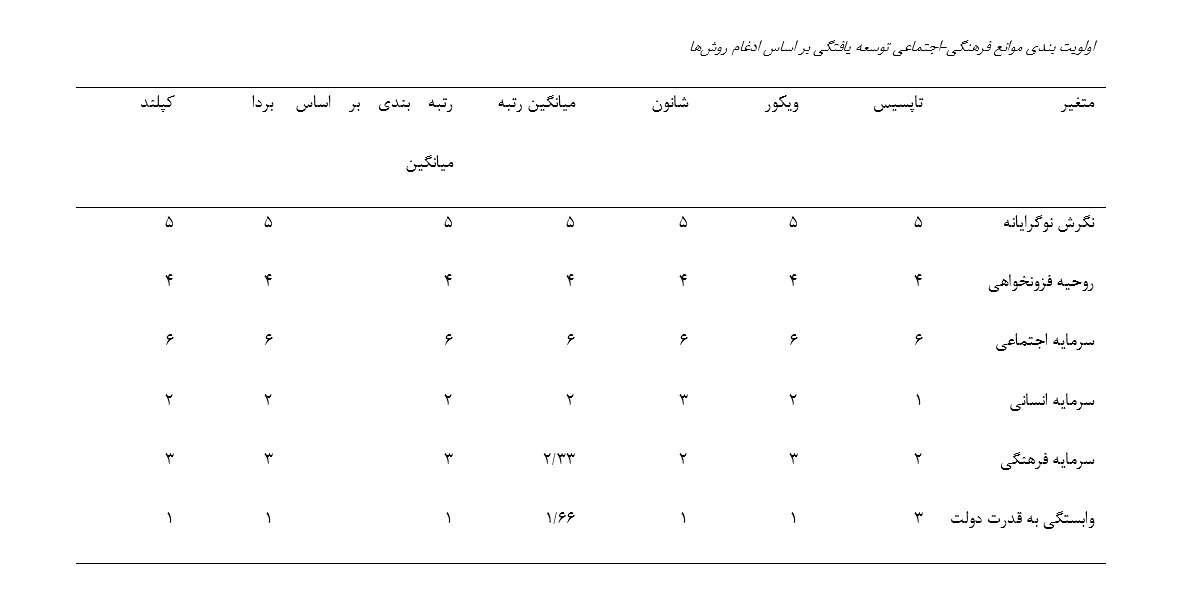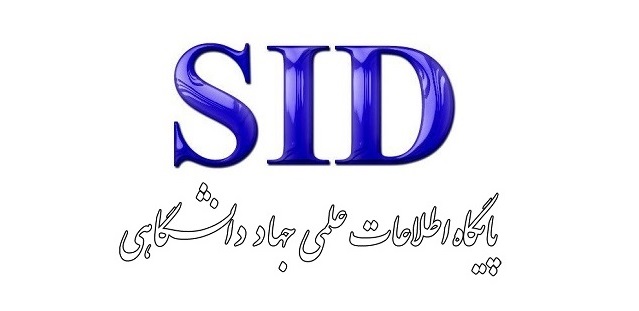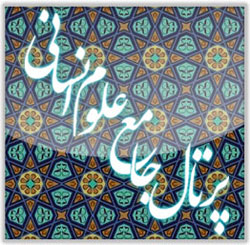بررسی جامعه شناختی موانع فرهنگی- اجتماعی توسعه یافتگی (مورد مطالعه: شهر بیله سوار)
کلمات کلیدی:
شهر بیله سوار, موانع فرهنگی- اجتماعی , توسعه یافتگیچکیده
توسعه مستلزم تغییر است و توسعهای كه به پیشبرد جامعه میاندیشد، بدون ایجاد تغییرات عمیق در ساختارهای اجتماعی- فرهنگی به وجود نخواهد آمد. این پژوهش با هدف بررسی موانع فرهنگی-اجتماعی توسعه یافتگی در شهر بیله سوار از یک سو از تکنیک پیمایشی و از سوی دیگر از روش نظریه زمینهای بهره گرفته است. در این راستا جامعه آماری تحقیق نیز در بخش کمی تعداد 400 نفراز شهروندان 20 سال به بالای این شهر با حداقل تحصیلات دیپلم که در صنوف مختلف مشغول بکار بودند و در بخش کیفی نظر 15 نفر از اساتید دانشگاهی، مدیران و افراد صاحب منصب خبره در حوزه اجتماعی و فرهنگی شهر بیله سوار که با استفاده از روش نمونهگیری هدفمند و با اشباع نظری انتخاب شدند، مورد بررسی قرار گرفتهاند. نتایج بخش کمی، حاکی از وجود رابطه معنادار بین تمامی متغیرهای مستقل: سرمایه اجتماعی، سرمایه انسانی، روحیه فزونخواهی، نگرش نوگرایانه، وابستگی به قدرت دولت، سرمایه فرهنگی و توسعه یافتگی شهر بیله سوار است. یافتههای بدست آمده در بخش کیفی نیز نشان داده که توسعه یافتگی شهر در شهر بیله سوارتحت تاثیر یکسری شرایط خاصی بوده است. این شرایط در سه مقوله اصلی که عبارتند از: شرایط علی شامل: فقدان نگرش نوگرایانه، ضعف سرمایه اجتماعی، وابستگی به قدرت دولت، ضعف سرمایه انسانی. شرایط مداخله گر شامل: ضعف سرمایه فرهنگی، عدم کارایی و اثربخشی و فقدان روحیه فزونخواهی. شرایط زمینهای شامل: موقعیت اکولوژیکی و میزان پایین سرمایه گذاری طبقه بندی میشوند. شرایط مذکور بطور کلی و در امتداد با یکدیگر باعث شده اند پدیدهای به نام توسعه نامتوازن (مقوله هسته) و عناصر آن وارد شهر بیله سوار شوند که مردم این شهر در برابر آن استراتژیهای خاصی را اتخاذ نمودند که میتوان در قالب تعارض با وضع موجود و سازگاری با شرایط حاکم دسته بندی کرد که پیامدهای آن با توجه به این شرایط تدوام توسعه نیافتگی، مهاجرت و کیفیت پایین زندگی ساکنان این شهر میباشد. با توجه به این یافتهها میتوان گفت متخصصان علل توسعه نیافتگی شهر بیله سوار را به مثابه توسعهای ناموزون و ناهماهنگ تفسیر میکنند.
دانلودها
مراجع
Adeli, M. R. (2003). The Concept of Underdevelopment. Monthly Journal of Business Studies.
Ale-Omran, R., & Ale-Omran, A. (2012). Measuring the Impact of Human Capital Promotion on Economic Growth in selected countries of OPEC. Journal of Science and Technology Parks & Incubators, 8(32), 41-53.
Anchorena, J., & Anjos, F. (2008). Social Ties and Economic Development. In.
Azizi, A., & Seydian Hashemi, S. (2016). Examining the Factors Influencing Social and Economic Development in Isfahan. Social Sciences of Shushtar, 10(1).
Azkia, M. (2010). Contemporary Social Theories with a Developmental Approach.
Azkia, M., & Ghafari, G. (2005). Sociology of Development. Keyhan Publications.
Babaei Fard, A. (2010). Cultural Development and Social Development in Iran. Scientific-Research Quarterly of Social Welfare, 10(37).
Borg, J. V. D., & Russo, A. P. (2005). The Impacts of Culture on the Economic Development of Cities. European Institute for Comparative Urban Research (EURICUR), Erasmus University Rotterdam.
Didari, C., Mohseni, R. A., & Bahrani, M. H. (2018). Examining Factors Affecting Underdevelopment in Kurdistan Province with Emphasis on Cultural Development. 37, 192-226.
François, P. (2002). Social Capital and Economic Development. Rutledge.
Ghavihoush, S. (2015). Examining the Cultural-Social Causes of Underdevelopment in Germi County Islamic Azad University, Science and Research Branch].
Grootaert, C., & Bastelaert, T. (2002). The Role of Social Capital in Development. Cambridge University Press.
Hesari, F., Rostami, F., Khosravi, S. A., & Jalilian, R. (2013). Examining Cultural Barriers Affecting Iran's Economic Development from the Perspective of Tehran University Students. Second International Conference on Management, Entrepreneurship, and Economic Development,
Jafarzadeh, J., Rostamzadeh, H., & Hassani Tabar, S. M. (2017). Determining and Analyzing the Development Levels of Counties in Ardabil Province. Human Settlements Planning Studies, 12(3).
Mardoukhi, S., & Saei Orsi, I. (2018). Explaining the Causes of Underdevelopment in Kurdistan Province, Iran (Using a Qualitative Approach). Iranian Journal of Social Development Studies, 11(1).
Misra, R. P., & Mabogunje, A. L. (1981). Regional Development Alternatives: International Perspectives. Maruzen Co. Ltd.
Moloudian, H., Zolfaghari, M., & Azimzadegan, M. (2015). Examining the Impact of Social and Cultural Factors on Economic Development. International Conference on Management, Culture, and Economic Development, Mashhad.
Piri, R., Karampour, R., & Kafashi, M. (2019). Examining Social Barriers to Development in Ilam Province Using Grounded Theory Method. Social Development Quarterly (formerly Human Development), 13(3), 163-196.
Popa, A.-M. (2012). The Impact of Social Factors on Economic Growth: Empirical Evidence for Romania and European Union Countries. Romanian Journal of Fiscal Policy, 3(2), 1-16.
Saberi, J. (2016). Examining Cultural and Social Factors Affecting the Underdevelopment of Kohgiluyeh and Boyer-Ahmad Province from the Perspective of Yasuj Citizens Islamic Azad University, Science and Research Branch].
Tavakoli, K. (1995). Cultural-Social Barriers to Rural Development in Saqqez County Faculty of Literature, University of Isfahan].
Zali, N., & Sajjadi Asl, S. A. (2017). Identifying Key Factors Affecting Regional Underdevelopment (Case Study: Kohgiluyeh and Boyer-Ahmad Province). Regional Planning Quarterly, 7(26).








